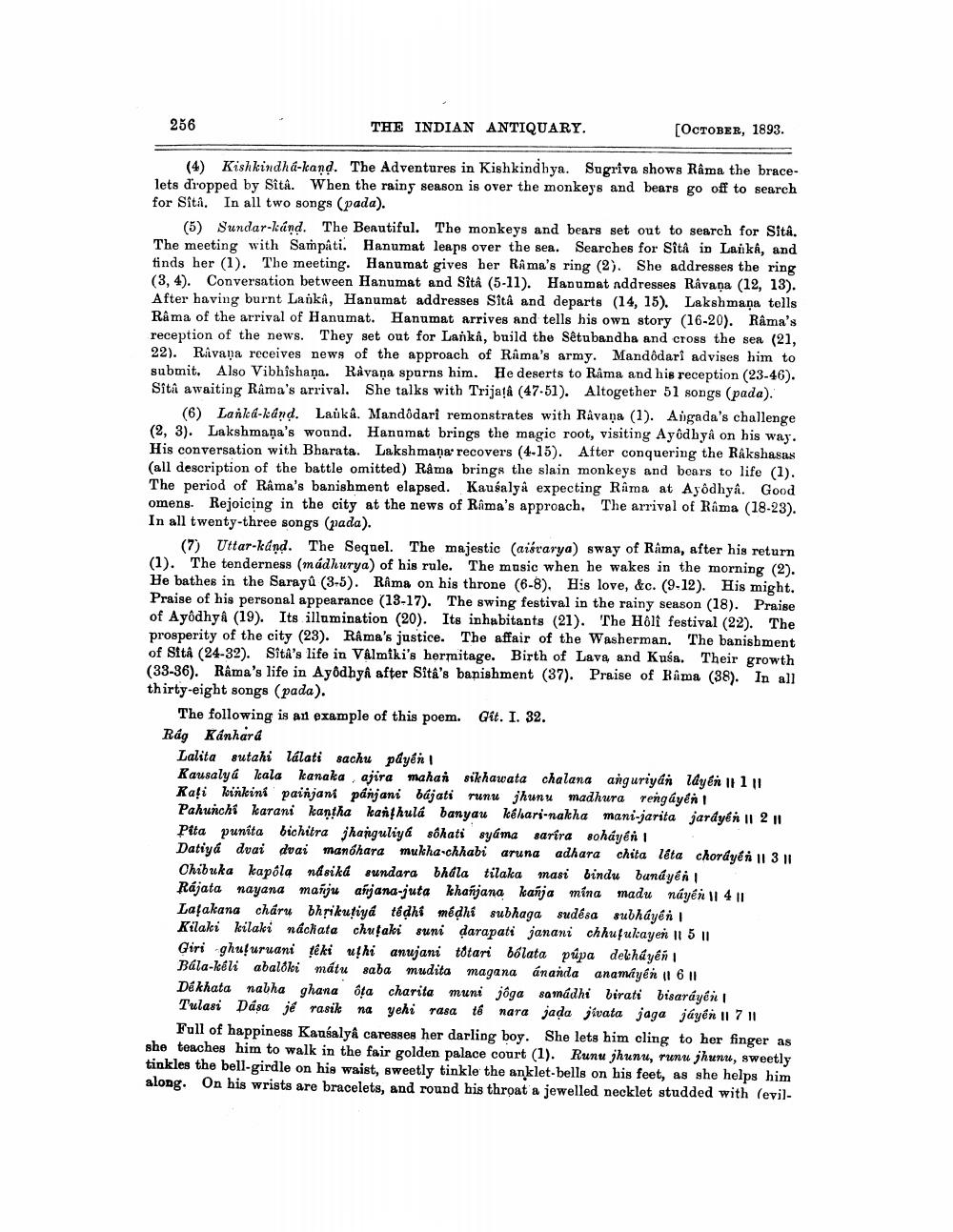________________
256
THE INDIAN ANTIQUARY.
[OCTOBER, 1893.
(4) Kishkindha-kand. The Adventures in Kishkindhya. Sugriva shows Rama the bracelets dropped by Sita. When the rainy season is over the monkeys and bears go off to search for Sita. In all two songs (pada).
(5) Sundar-kand. The Beautiful. The monkeys and bears set out to search for Sita. The meeting with Sampâti. Hanumat leaps over the sea. Searches for Sita in Lanka, and tinds her (1). The meeting. Hanumat gives her Râma's ring (2). She addresses the ring (3, 4). Conversation between Hanumat and Sîta (5-11). Hanumat addresses Râvaņa (12, 13). After having burnt Lavka, Hanumat addresses Sitâ and departs (14, 15). Lakshmana tells Rama of the arrival of Hanumat. Hanumat arrives and tells his own story (16-20). Râma's reception of the news. They set out for Lanka, build the Setubandba and cross the sea (21, 22). Ravaņa receives news of the approach of Rama's army. Mandödari advises him to submit. Also Vibhishaņa. Råvaņa spurns him. He deserts to Râma and his reception (23-46). Sitâ awaiting Rama's arrival. She talks with Trijatā (47-51). Altogether 51 songs (pada).
(6) Lanka-känd. Lanka. Mandödari remonstrates with Ravana (1). Angada's challenge (2, 3). Lakshmana's wound. Hangmat brings the magic root, visiting Ayodhyâ on his way. His conversation with Bharata. Lakshmana recovers (4-15). After conquering the Rakshasas (all description of the battle omitted) Råma brings the slain monkeys and bears to life (1). The period of Rama's banishment elapsed. Kausalya expecting Rama at Ayodhyâ. Good omens. Rejoicing in the city at the news of Rama's approach. The arrival of Rama (18-23). In all twenty-three songs (pada).
(7) Uttar-kúnd. The Sequel. The majestic (aisrarya) sway of Rama, after his return (1). The tenderness (mádhurya) of his rule. The music when he wakes in the morning (2). He bathes in the Sarayû (3-5). Rama on his throne (6-8). His love, &c. (9.12). His might. Praise of his personal appearance (13-17). The swing festival in the rainy season (18). Praise of Ayodhya (19). Its illumination (20). Its inhabitants (21). "The Holi festival (22). The prosperity of the city (23). Rama's justice. The affair of the Washerman. The banisbment of Sita (24-32). Sita's life in Valmiki's hermitage. Birth of Lava and Kuss. Their growth (33-36). Rama's life in Ayodhyâ after Sita's banishment (37). Praise of Bima (38). In all thirty-eight songs (pada).
The following is an example of this poem. Git. I. 32. Rág Kanhara
Lalita sutahi lalati sachu pdyer Kausalya kala kanaka ajira mahai sikhawata chalana anguriyan idyen 11111 Rați kinkini painjani pánjani bájati runu jhunu madhura rengáyên! Pakunchi karani kantha kantkulá banyau kéhari-nakha mani-jarita jardyen || 2 || Pita punita bichitra jhanguliya sôhati syama sarira scháyén Datiyá dvai dvai manbhara mukha-chhabi aruna adhara chita léta chordyéi 11 3 11 Ohibuka kapóla nå sika sundara bhala tilaka masi bindu bundyên Rájata nayana manju anjana-juta khanjana kanja mina madu náyére 11 4 11 Latakana cháru bhrikutiya têdhi médhi subhaga sudésa subháyên Kilaki kilaki náchata chutaki suni darapati janani chhufulayer 11 5 11 Giri ghufuruani têki uthi anujani tătari b6lata púpa dekháyên Bála-kéli abaldki mátu saba mudita magana ananda anamiyén (1 6 11 Dékhata nabha ghana ota charita muni jóga samadhi birati bisaráyên Tulasi Dása jê rasik na yehi rasa té nara jada jivata jaga jáyên 11 7 11
Full of happiness Kausalya caresses her darling boy. She lets him cling to her finger as she teaches him to walk in the fair golden palace court (1). Runu jhunu, runu jhunu, sweetly tinkles the bell-girdle on his waist, sweetly tinkle the anklet-bells on his feet, as she helps him along. On his wrists are bracelets, and round his throat a jewelled necklet studded with (evil




